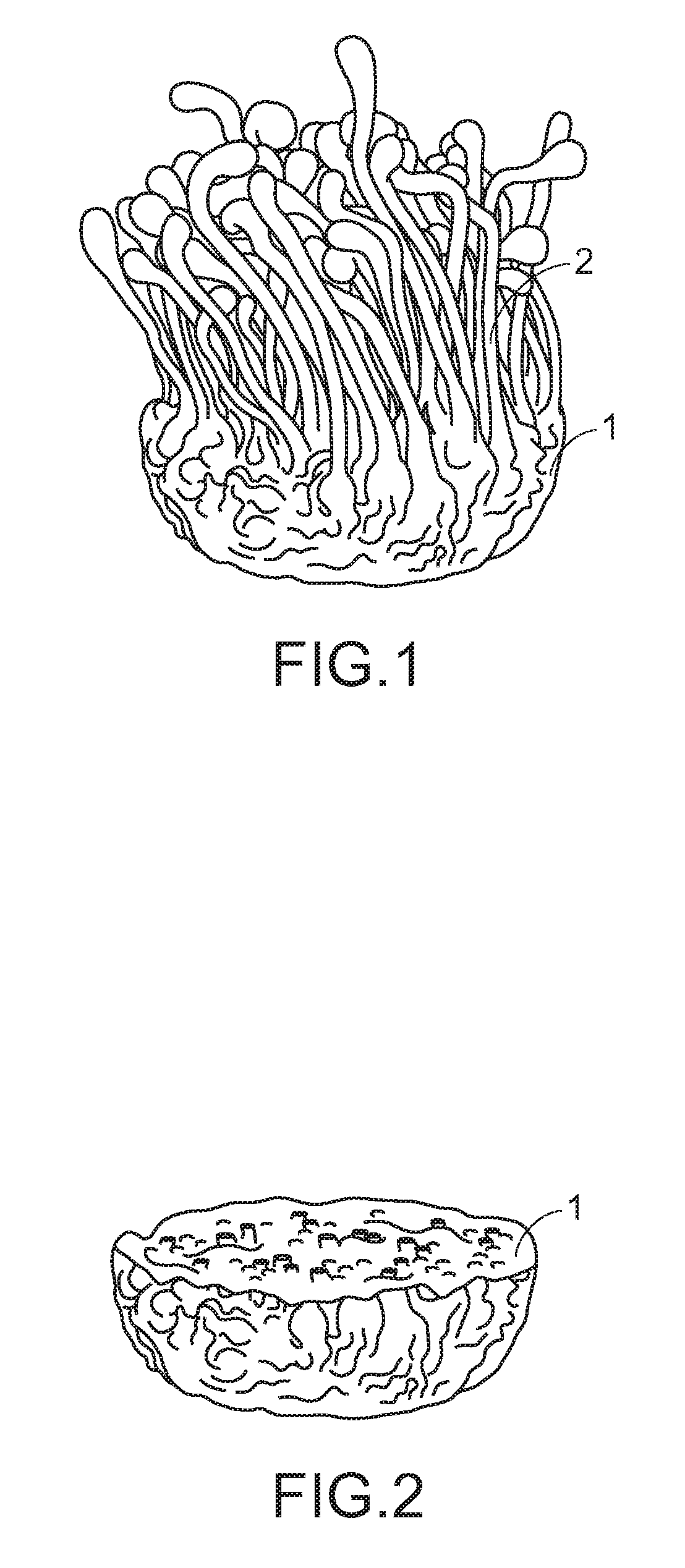Method for producing gamma-aminobutyric acid by fermenting rice medium from preparation of cordyceps species and application thereof
- Summary
- Abstract
- Description
- Claims
- Application Information
AI Technical Summary
Benefits of technology
Problems solved by technology
Method used
Image
Examples
experiment 1
alysis of the Rice Medium
[0059]In accordance with the Association of Official Analytical Chemists (A.O.A.C.) Official Methods of Analysis (1980), the contents of moisture, ash, crude protein, crude fat, and crude fiber are determined (do experiments in triplicate).
[0060]Please refer to the following table 1, which shows the component analysis of a rice medium after fruiting bodies of Cordyceps militaris are cultivated on cooked rice. The analysis results show that the rice medium is mainly composed of carbohydrate (83.59±0.36%) and followed by crude protein (9.24±0.1%), crude fiber (5.61±0.36%), crude fat (1.31±0.03%) and ash (0.25±0.01%). The crude protein content of the rice medium (9.24%, on a dry weight basis) is obviously higher than the general rice protein content (about 7%, on a dry weight basis), which is collected and published by Department of Health, Executive Yuan, R.O.C. (Taiwan). It means that after the cooked rice is infiltrated by the mycelia of the Cordyceps milita...
experiment 2
Lactic Acid Bacteria Strains
[0063]Ten lactic acid bacteria strains having the potentials to produce γ-aminobutyric acid are screened from 126 isolated strains of lactic acid bacteria. After further screening, five strains with the highest productivity of γ-aminobutyric acid are selected. FIG. 5 is the thin layer chromatography result showing the γ-aminobutyric acid produced by ten lactic acid bacteria strains. From left to right of the chromatogram, a γ-aminobutyric acid standard, a sodium glutamate standard, a FPP 3713 strain, a FPA 3708 strain, FPA 3709 strain, FPM 3702 strain, FPS 2520 strain, FKR 2526 strain, FPAW 3778 strain, FKR 3737 strain, FKR 3739 strain, and a FKR 3741 strain are sequentially shown. The experimental results show that the FPA 3709 strain, the FPP 3713 strain, the FKR 3737 strain, the FKR 3739 strain, and the FKR 3741 strain produce more γ-aminobutyric acid. Consequently, these five strains are selected for performing the subsequent experiments.
experiment 3
minobutyric Acid Productivity of the Lactic Acid Bacteria in the Rice Medium Suspension
[0064]Use a tweezer to put a lump of rice medium into a sterile storage bag, and crush said rice medium into rice medium powders in a mortar (a bowl for grinding materials), which has been subjected to sterilization at 121° C. for 15 minutes. Seal this sterile storage bag with the rice medium powders in it and then stored it in the refrigerator at 4° C. These rice medium powders would be used in preparing the rice medium suspension (in full aseptic treatment).
[0065]Then, 12 g of rice medium powders is weighed, and is placed into 100 mL of distilled water, which has been subjected to sterilization at 121° C. for 15 minutes. This is the suspension containing 12% of rice medium. Then, a lactic acid bacteria strain is added to the suspension such that the initial count of the lactic acid bacteria strain is 5.0˜6.0 log CFU / mL. Then, the mixture of the lactic acid bacteria strain and the suspension (als...
PUM
| Property | Measurement | Unit |
|---|---|---|
| concentration | aaaaa | aaaaa |
| concentration | aaaaa | aaaaa |
| concentration | aaaaa | aaaaa |
Abstract
Description
Claims
Application Information
 Login to View More
Login to View More - R&D
- Intellectual Property
- Life Sciences
- Materials
- Tech Scout
- Unparalleled Data Quality
- Higher Quality Content
- 60% Fewer Hallucinations
Browse by: Latest US Patents, China's latest patents, Technical Efficacy Thesaurus, Application Domain, Technology Topic, Popular Technical Reports.
© 2025 PatSnap. All rights reserved.Legal|Privacy policy|Modern Slavery Act Transparency Statement|Sitemap|About US| Contact US: help@patsnap.com



